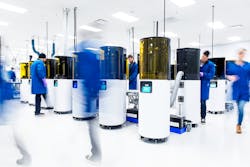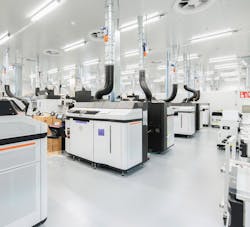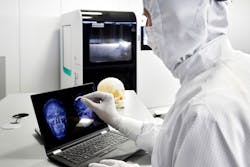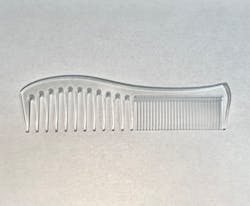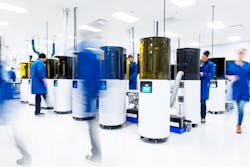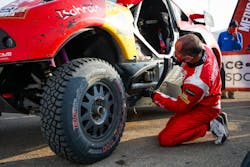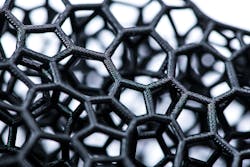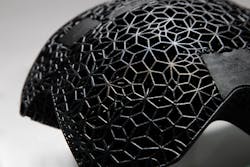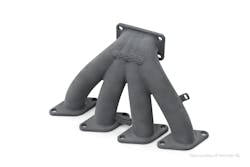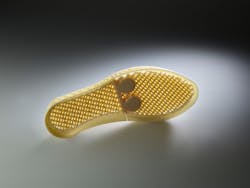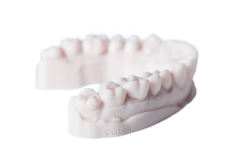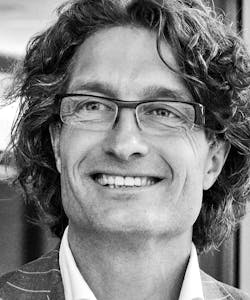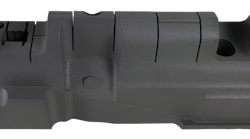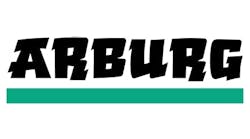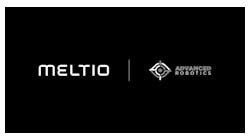By Karen Hanna
At Bennett Plastics in Paterson, N.J., members of the 40-employee workforce can transform a brand owner’s idea into an injection molded part.
Often, the process starts with a 3-D printer.
While many 3-D printers are still constrained by slow speeds, relatively small build volumes and limited material options, the technologies are growing in popularity as complements to traditional manufacturing processes. 3-D printer makers and users cite a number of advantages — starting with prototyping.
Other benefits for parts makers and brand owners include faster time to market, easier scale-up from short runs to commercial-level volumes, the flexibility to take on new projects in-house, expanded design freedom and the ability to customize. Advances in materials and software could further expand applications.
“Digital manufacturing — and the power that 3-D printing has to revolutionize manufacturing — will continue to be a transformative driver of growth across a variety of segments, including orthotics, footwear, tooling and beyond,” predicted Ramon Pastor, global head of 3-D printing technology, operations and metals for HP.
First things first
One month into a new job as director of sales and marketing for Champion“A close friend of mine, he invented a new product that has about 20 different molded pieces, and he's trying to bring this to market, and there's no way he could have ever afforded to tool up 20 different pieces. Having to get them 3-D printed allows him to get this product to market,” he said.
With no time or expense devoted to tooling, 3-D printing technologies seem tailor-made for the proof-of-concept and prototyping process.
Consumer products typically need 18 to 24 months to make their way to market, said Hardik Kabaria, director of software engineering at Carbon.
“But when we put the best design tools, 3-D printers and additive materials in the hands of designers and manufacturers, we’ve seen our customers accelerate the development of innovative new products, going from idea to finished designs to production in less time,” he said.
Arburg’s use of its Freeformer additive-manufacturing machine to prototype a face mask early in the COVID-19 crisis illustrates the advantages — the product hit the market within 41 days.
Avoiding the need for tooling makes manufacturers more agile, said Michael Mignatti, VP of engineering at MakerBot. A mold might take three to four weeks to cut and cost $500,000. Regardless of the size or shape of the part, the mold most likely would be a square, huge block of metal, with a significant amount of material wasted as scrap — all for a plastic part that, at least in the proof-of-concept phase, ultimately might not work at all.
Alternatively, manufacturers can cut models from foam, but that won’t tell them whether a part will perform as designed.
“We've done things in the past where maybe we can't get the right material or the right technology that can build the part we want. We may actually pay for a mold and do it and test it, and then scrap that and pay for another one that's actually the production part that we want to get. So, it's expensive, it's time-consuming,” Mignatti said.
As more resins are adapted to printing, 3-D printers increasingly can produce parts that function just as they might if they had been injection molded.
“I think any time that you can offer them a total solution, where you're involved early on in the design, you can help them tweak the design, print a part and try it out. And they say, ‘Yeah, this drafting is not right the way it is, let’s print another one,’ which historically, they would have to pay for a prototype. So, for us to be involved early on in their design cycle is beneficial to them,” Ignatowski said. “Because we help them design for manufacturing, it's also beneficial for us.”
For Champion, which runs 10 presses with clamping forces ranging from 85 tons to 300 tons, 3-D printers also provide a prototyping benefit molders of small parts never before enjoyed — the chance to scale up their products to get a closer look at them.
“Just to be able to touch and feel on a larger scale sometimes just makes it a little bit easier during the design process,” Ignatowski said.
Scaling up
Just as 3-D printers can help manufacturers scale up parts, they also can help them transition from prototyping and small-batch production to running larger volumes of parts — a stage known as bridge production. Because 3-D printers give manufacturers the ability to go directly from design to prototype or part, short runs that would not be feasible for injection molders now can generate profit.
The math could add up for traditional manufacturers, like Bennett, where 3-D printers are used mostly for prototyping, but sometimes for production.
“If someone doesn't want to invest in tooling, but needs let's say 100 pieces of a product, that's also where 3-D printing can come in as a valuable process,” Bachrach said.
3DChimera, which offers all things 3-D printing, including contract printing services, has seen a growing number of manufacturers make the leap from outsourcing production of some parts to investing in printers themselves, Hussain said.
“Our 3-D printers range from as little as 5,000 bucks up to maybe 100K. For our average production 3-D printers or manufacturing-quality 3-D printers, the price is right around $50,000. So, you could bring in 10 or 20 of those machines, and it would cost you less than an injection mold. One machine can make you 500 parts [in a production run], right? Twenty machines can make you 20 times that, and so that's where you start to see crazy efficiency come out of this equipment,” Hussain said.
“One machine can allow you to accept small jobs you might have otherwise turned down, and many machines can allow you to potentially replace that previous production technology.”
In recent years, farmers and restaurateurs have adopted the farm-to-table approach, but they’re not the only ones looking to simplify the supply chain. For manufacturers, 3-D printers can provide a quick way to fill a need for a part.
The flexibility that 3-D printers offer has been especially apparent during the pandemic. For some companies, 3-D printers have helped to “open up totally new lines of business,” Hussain said. Now, instead of accepting only jobs that required a minimum of 5,000 or 10,000 parts, they can profit from as few as 50.
“If you were a gig worker, you might call it your side hustle to have a little Etsy shop or something,” Hussain said. “It's like these businesses have completely legitimate side hustles selling products to end customers that are related, but not directly in competition, to how they service their existing customer base.”
According to Hussain, Fortune 100 companies — among 3DChimera’s biggest customers — withdrew their investments in 3-D printing technology when the pandemic hit. But smaller companies stepped into the gap, looking for ways to fabricate parts that suddenly were hard to source. For them, 3-D printing offered a lot of benefits.
To see the benefits of being able to print on-site, look no further than the 4,751-mile Dakar Rally through the Saudi Arabian desert. There, MakerBot printers were on the scene to 3-D print parts at the moments and places they were needed.
The approach ensured participants could make immediate repairs. And the printers — and the carbon-fiber-reinforced parts they made — were up to the unforgiving demands of a race set in high temperatures over sand dunes at 100-plus miles per hour.
“Some of it was relatively simple, like cooling ducts,” said MakerBot’s Mignatti. “Some of it was more structural that would need to hold up some, like a cylinder or a bracket in the back of the car.”
Design freedom
In addition to their other benefits, 3-D printers can produce unmoldable parts, with designs that allow lighter weights or a variety of material properties. In some cases, that includes automotive ductwork.
Rik Jacobs, 3D Systems’ VP of the application innovation group and“For some parts,” he said, “it's the only technology” suitable for geometric design, component consolidation, complicated fluid-flow requirements or lightweighting.
One company exploring the possibilities outside the constraints of injection molding is Rize, which makes printers that can apply as many as six additives selectively, one tiny section, or voxel, of a part at a time. This means that one part can sport multiple colors, or, in the future with further advances, be both hard and soft, flexible and rigid.
“You can put in functional inks and additives. Through the 3-D print process, we can change the material property at what is called a voxel level,” said Andy Kalambi, the CEO of Rize, a maker of 3-D printers and proprietary software. “So, suddenly, what you have is, if you want something soft at one place and hard at another place, if you want electrically conductive stuff inside the part without having to put a circuit on a wire harness, all of those possibilities are the ones that 3-D printing will deliver on. I think that’s where the true innovation and the true value will come, which is the ability to play with material science.”
The design freedom of 3-D printing also supports sustainability strategies, such as lightweighting, according to Jacobs; Martin Neff, Arburg’s head of plastic Freeforming; and Carbon’s Kabaria.
As with many 3-D printing technologies, the Arburg Plastic Freeforming (APF) process involves the production of a part through the precise drop-by-drop distribution of resin.
“The droplet-based discharge method and the design of the support structures make it possible to create hollow bodies, complex lightweight structures and component walls that are just a few layers thick. The support material is then simply dissolved in the water bath; there is no need to remove it separately,” Neff said.
“3-D printing enables the production of latticed parts that can deliver considerable mechanical performance advantages beyond those that can be produced via traditional production methods. In particular, we found lattices to be 3-D printing’s strong suit because they allow designers to specify the characteristics required for the part at every millimeter — ultimately changing the face of next-gen product design,” he said.
Have it your way
Part design and part expectations are changing. Someday, we might have access to printers that evoke the Star Trek Replicator — anything you want at the touch of a button. While that’s not possible — yet—some applications are pointing the way toward the future. Parts like bike seats, helmets and shoes can be made to suit the consumer.
“As companies, governments and suppliers recognize the call for greater personalization, we’re seeing more interest in the adoption of 3-D printing to both meet demand and empower mass customization,” HP’s Pastor said.
The medical industry, in particular, is one market where 3-D printing has found a niche, according to representatives from Arburg, Rize and HP. Health-care professionals are using 3-D printers to make orthodontics, implants, eyeglasses and other parts.
Neff cited several advantages that the APF process presents to the health-care industry. They include benefits also offered by other 3-D printers: clean-room compliance and traceability.
"The research projects that are currently under way are looking at subjects including how the APF process could be implemented in clinics in the future so that they can produce patient-specific implants right there on site,” Neff said. “Another example of current research is considering how to produce tablets with custom additive manufacturing, which can then release their active ingredients in the body over a specific length of time.”
Doctors also can use 3-D printers to produce tailor-made implants, as well as models of organs or bones, Rize’s Kalambi said.
“They are looking what can be done on point of care and personalization. So, you know, I need my heart to be printed in terms of seeing any issues that may be there, or my bone to be printed, and that's personalization, so it's more personalized health-care kind of applications that are being done,” he said.
According to Pastor, HP provides its Multi Jet Fusion 3-D printers to SmileDirectClub, an orthodontics company. The technologies also make eyeglasses.
“Not only is HP helping establish the company as a leader in personalized dental solutions, but it’s also supporting the company as it democratizes access to dental care and disrupts the $12 billion orthodontics industry. With HP’s Multi Jet Fusion technology, SmileDirectClub produces 40,000 molds a day,” Pastor said.
“We work with a company, for example, to take CT MRI scans, which are digital in nature, and then make them into 3-D printable files, so that you can get things like this bone ... this orthopedic part, which is used by surgeons for pre-surgery planning. That piece of software is also evolving, where people are looking at how to drive the scan-to-print automation,” he said.
Charting the future
As new materials become available and expertise involving design principles expands, OEM representatives and 3-D printer users expect the technologies to gather more momentum in manufacturing.
“As companies continue to seek out solutions that prioritize the ability to customize and create to specific needs, we believe 3-D printing will be leveraged as the core technology enabling full-volume production,” Pastor said.
At Champion, 3-D printing is still a side gig. The company doesn’t advertise it on its website, using third-party service bureaus instead, to provide prototyping and part-optimization services to its customers. But that could change.
Material offerings remain an important limitation, but Champion is looking to the future — it’s considering making an investment to bring printers in-house, he said.
3D Systems’ Jacobs predicts molders increasingly will offer 3-D printing services, as well.
“When you have a very simple design, you have a standard type of plastic, and you have to produce a few hundred thousand parts, then injection molding is the cheapest technology to use for that, and that's also the reason why it was so popular for many years. It's very hard to use a printing technology and compete ultimately with the price per part,” he said. “But as soon as you have low volumes, or complex designs, or different kinds of requirements, like part consolidation, weight reduction, fluid-flow mechanisms, then additive comes into place.”
Karen Hanna, associate editor[email protected]Contact:
3DChimera, Miami, 786-701-0700, www.3dchimera.com
3D Systems Inc., Rock Hill, S.C., 803-326-3930, www.3dsystems.com
Arburg Inc., Rocky Hill, Conn., 860-667-6500, www.arburg.com
Carbon Inc., Redwood City, Calif., 650-285-6307, www.carbon3d.com
HP Inc., Palo Alto, Calif., 650-857-1501, www.hp.com
MakerBot Industries LLC, Brooklyn, N.Y., 347-334-6800, www.makerbot.com
Rize Inc., Concord, Mass., 978-699-3085, www.rize3d.com
